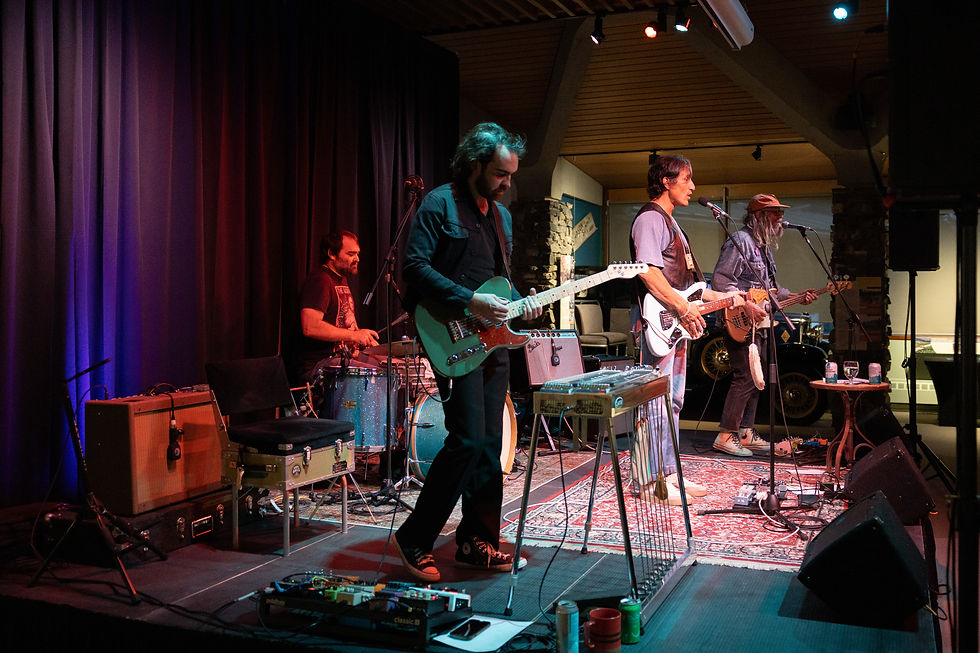Connecting with Nature Through New Exhibitions
- Jan 27, 2022
- 6 min read
Last weekend brought a special kind of excitement that we haven't experienced in a while - an excitement that can only be felt while coming together with community. On Saturday, January 22nd, the Whyte Museum of the Canadian Rockies hosted the first live Exhibition Opening since 2020. Five new installations featuring diverse artists, mediums, and topics were celebrated and explored. Working within the ever-evolving COVID-19 realities, this full-day weekend event allowed time and space for visitors to take in the exhibit, while still having the opportunity to meet and learn from the artists.
Donna Livingstone, CEO of the Whyte Museum, welcomed visitors with words about the importance of connecting with nature.
"I believe that artists are the cultural and environmental first responders," she said.
"They are the ones who notice change in the world around them and their insight – funny, poignant, angry or just plain beautiful – give us an opening into difficult conversations. All of the artists in these five exhibitions are environmental first responders. This is a theme that isn’t accidental."
As you explore these exhibitions, we hope they offer opportunities to reflect on what nature means to you, and how we can best use our place in nature for a better future.
Collage 1
Exhibition Information
Rockies Repeat: Chasing Beauty in a Disappearing Landscape
Main Gallery
January – April 2022

Image 1
Rockies Repeat: Chasing Beauty in a Disappearing Landscape is a multimedia exhibition
that grapples with the cultural impacts of climate change in the Canadian Rockies.
This diverse collection juxtaposes the landscapes of Catharine Robb Whyte with fresh
interpretations by six contemporary artists. Familiar places are captured and exhibited alongside
Catharine’s earlier paintings. For two years, a team of Indigenous and settler artists trekked into
the mountains to the exact places Catharine painted en plein air nearly a century ago.
Like Robb Whyte, the artists were confronted by the whims of nature but unlike her experience,
these present-day artists endured record-breaking temperatures, horizons obscured by wildfire
smoke, and backdrops besieged by climate change. Catharine’s scenes of majestic peaks,
dense glaciers, and lush thriving forests seem incongruous aside the recent artistic content.
Part of the exhibition experience is Rockies Repeat, a story captured in a short documentary
that is a meditation about human connections to disappearing landscapes. The film explores the
enduring legacy of Catharine Robb Whyte, the importance of sustaining traditions on ancestral
lands, and the impact of a changing climate on our sense of place.
Organizer Caroline Hedin asserted: “I hope this collection reminds you of how central the glacial
landscape of the Rockies is to our identity as mountain people, yet how fragile its future remains
in the face of climate change."
The exhibition is part of the Alberta Exposure Photography festival.
Iconic Rockies: The Photography of John E. Marriott
Main Gallery
January – April 2022

Image 2
The exhibition features images that have defined the impressive career of one of Canada's
most recognized professional wildlife photographers, Canmore resident John E. Marriott.
Marriott is known globally for his spectacular imagery from across Canada.
It is Marriott's iconic wildlife encounters close to home in the Canadian Rockies that have
often resonated the most with his fans and followers. A magical run-in with Canada's most
famous wolf, Delinda; a late-night brush with the legendary grizzly bear The Boss; a two-
day meeting with a mother cougar and her kitten; and a blizzard-induced encounter with a
fluffed-up raven.
Marriott’s successful career has resulted in magazine covers, bus wraps, billboards, and the
publication of numerous books. As well as being a Canon Ambassador, Marriott received
special recognition from the international Wildlife Photographer of the Year competition.
In addition to these accolades, he is an Associate Fellow with the International League of
Conservation Photographers and the co-founder of the Exposed Wildlife Conservancy.
Elise Findlay: Under the Mountain's Shadow
Main Hallway
January - April 2022

Image 3
The installation Under the Mountain’s Shadow explores and brings awareness to the
challenges that face residents and visitors in resort towns. The beauty of the place and the
"Peter Pan" attitude towards life in a resort town has a shadow—a darker side that results in
increased rates of sexualized violence, domestic and intimate partner violence, as well as
challenges with addictions and mental health. These issues are even more challenging because
along with the high turnover of people and the younger population, most business and employers
in resort towns rely on the tourist industry and its accompanying image of pristine natural
beauty—leaving little space to acknowledge, discuss, or improve.
The triptych and installation, depicting a semi-abstract landscape of the town of Banff, is built up
of trash collected from around the townsite, printed statistics, and comments from an informal
survey and research conducted during the project. The trash reflects the less picturesque as well
as the disappointing behaviour of visitors and locals alike in the National Park. While the
statistics from the survey which address sexualized violence, domestic and intimate partner
violence, addictions, and mental health are not perhaps surprising given provincial statistics, they
are hard to face as a community. Yet, there is hope to be found in the Bow Valley. With shifts in
attitudes, new programs to educate and support the community, and an increasing willingness to
talk, the shadow that hangs over this beautiful place many of us love is shifting into the light.
Under the Mountain’s Shadow expresses both the darkness and the light and is part of a larger
ongoing community-building project.
Michael Corner: What I Did Last Summer
Philippe Delesalle stairway
October 26, 2021 – April 4, 2022

Image 4
With Covid-19 imposing restrictions and interrupting routines, the Whyte Museum
launched a trial artist-in-residency invitation to local artist Michael Corner to spend the
summer working out of the Mather Cabin. Located on the Whyte Museum property, the
cabin is noticeable for its whitewashed exterior. Once part of the boathouse operation
located across the Bow River, the Mather Cabin was situated close to where the new Nancy
Pauw pedestrian bridge will span.
During Corner’s first few days in the cabin, nightmarish spiders and bygone anecdotes
unsettled the artist but he soon settled into a rhythmic pattern of painting subjects familiar
in his practice. Corner’s paintings of exterior views capture elements of both the Whyte
home, Sinclair and Peyto cabins with pathways through the wooded lawn taking the viewer
farther afield. The human figure features predominantly in his interior scenes, making the
cabin space appear larger than its minimal dimensions. Finally, Corner’s paintings of
figures submerged in black represent a historic event when the river overflowed its banks
and flooded the space.
Learn more about Corner's experience creating in the Mather cabin.
From the Collection: The Photography of Edward Burtynsky
Main Gallery
January 21 – April 4, 2022

Image 5
Edward Burtynsky was born of Ukrainian heritage in St. Catharines, Ontario. From the mid-
1970s to early 1980s, Burtynsky formally studied graphic arts and photography obtaining a
diploma in graphic arts from Niagara College in Welland, Ontario, in 1976, and later a BAA
in Photographic Arts (Media Studies Program) from Ryerson Polytechnical Institute in
Toronto, Ontario, in 1982.
Burtynsky's most famous photographs are sweeping views of landscapes altered by
industry: mine tailings, quarries, scrap piles. The grand, awe-inspiring beauty of his images
is often in tension with the compromised environments they depict. Vast human-altered
landscapes expose the astounding scale of infrastructure and destruction fuelled by
enterprise and consumption.
Burtynsky’s early influences include Ansel Adams, Edward Weston, Eadweard Muybridge,
and Carleton Watkins, whose prints he saw at the Metropolitan Museum of Art in the early
1980s. Another group whose body of work shares similar themes and photographic
approaches to Burtynsky's work are the photographers who were involved in the
exhibition New Topographics: Photographs of a Man-Altered Landscape. Curated by William
Jenkins at the International Museum of Photography at the George Eastman House
(Rochester, New York), the October 1974 exhibition epitomized a key moment in American
landscape photography.
In the publication Oil Culture published in print in 2014 and online in 2015, Catherine
Zuromskis’s essay Petroaesthetics and Landscape Photography New Topographics, Edward
Burtynsky, and the Culture of Peak Oil (Part IV, Chapter 15) examines both the
aforementioned 1975 exhibition and a 2009 traveling exhibition of Edward Burtynsky’s
photographs of oil landscapes, entitled Burtynsky: Oil. As promoted by the Minnesota
Scholarship Online, “the two exhibitions explore the quiet resonances of unease and
anxiety that structure contemporary landscape photographers’ visions of petro modernity.
It considers what landscape photography does to frame both the oil industry and the
pervasive petro culture it supports on both a political and an affective level.”
Most of Burtynsky's pre-2007 exhibited photography was taken with a large-format field
camera on large 4x5-inch sheet film and developed into high-resolution, large-dimension
prints of various sizes and editions ranging from 18 x 22 inches to 60 x 80 inches. He often
positions himself at high-vantage points over the landscape using elevated platforms, the
natural topography, and more currently helicopters and fixed-wing aircraft.
Over time, Burtynsky has received numerous awards such as becoming an officer of the
Order of Canada’s Officer in 2006; honorary doctorates from Mt. Allison University, Queens
University, Ryerson University, and Boston’s Montserrat College of Art. He is a member of
the Royal Canadian Academy of Arts and the recipient of the Geological Society of America
Presidents award. Recently the World Photography Organization announced Burtynsky as
the Outstanding Contribution to Photography recipient of the Sony World Photography
Awards 2022 held at Somerset House, London. Burtynsky is the 15th photographer to
receive this prestigious and rare international honour.
Burtynsky’s photography is held in over 60 major museums around the world including the
Whyte Museum, whose holding includes 36 works dating from 1983 to 2012. The exhibition
features an overview of the Burtynsky collection.
Images:
Gallery 1: All photos by D.L. Cameron at the Exhibition Opening at the Whyte Museum of the Canadian Rockies, January 22nd, 2022.
Image 1: Kerry Langlois, Smoke Show, Lake McArthur, 48 " x 48", Acrylic on cradled birch panel, Collection of the Artist, courtesy of Canada House Gallery.
Image 2: John E. Marriott, Raven, Collection of the Artist.
Image 3: Elise Findlay, Under the Mountain's Shadow, Mix medium, acrylic paint, and Banff pathway and street garbage, 2021.
Image 4: Michael Corner, Two figures no. 4, Oil on board, 2021.
Image 5: Edward Burtynsky, Alberta Oil Sands #6, photograph on board, 2007.































Comments